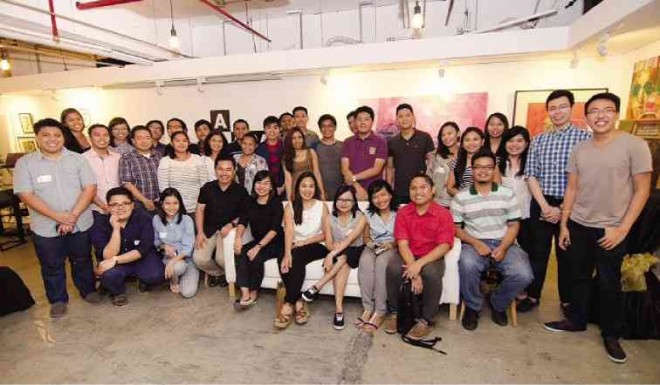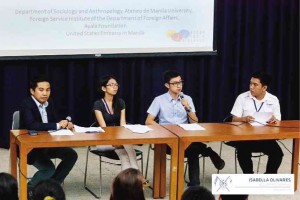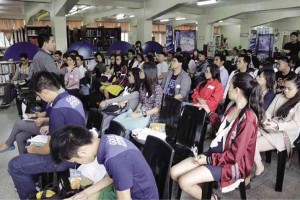Caravan prepares youth for ‘One Asean’
A caravan has been encouraging young people to talk and learn about the integration of the Association of Southeast Asian Nations (Asean).
Asean Youth Dialogues (AYD), the brainchild of five young professionals, has been conducting since 2014 no-holds-barred discussions on Asean integration.
The dialogues adhere to the “Asean way,” employing the open, nonconfrontational and consensual approach that distinguishes the regional grouping from other regional blocs such as the European Union.
The organizers of AYD are good governance advocate Angel Bombarda, journalist Janvic Mateo, social researcher John Patrick Allanegui, medical technologist Gab Pascual and the writer, a public health physician.
At the AYD dialogues, participants explore the implications of Asean integration, not just on the economy, which is the usual focus of Asean-related discussions, but on all aspects of society—from education and employment to environment and regional security.
Article continues after this advertisementParticipants include students and youth leaders of diverse backgrounds. Resource persons are experts on Asean integration.
Article continues after this advertisementAsean, of which the Philippines is a founding member, has been working on full regional integration for nearly a decade, guided by the motto “One Vision, One Identity, One Community.”
This year, Asean will gauge the preparedness of its member countries for integration.
Not ready
An Asean Economic Scorecard developed by the Asian International Economists Network reported in 2013 that 66 to 86 percent of integration targets had been achieved.
But a report from the Asian Development Bank last year found that no Asean member country was ready for economic integration.
Asean peoples, in general, were found to be not prepared for integration. One study noted that three out of four people “lack a basic understanding” of Asean.
Another report said, among Southeast Asian youths, Filipino and Burmese students had the lowest levels of Asean awareness.
AYD has conducted four dialogues since August in the cities of Quezon, Davao, Baguio and Makati.
Malaysian colleagues of the Filipino organizers held their own AYD sessions, gathering some 400 youths in Kuala Lumpur to discuss Asean integration’s impact on their country.
AYD has so far reached nearly 800 youth leaders in the Philippines and Malaysia, as well as about 5,000 more through social media.
The message AYD is trying to convey is for the youth to embrace Asean integration with critical understanding. They should study carefully the many aspects of regional integration to ensure that its benefits are harnessed while the potential harm it may cause to societies, especially the poor, marginalized and vulnerable, is reduced.
At the inaugural session at the Ateneo de Manila University, Teresita Daza, executive director for Asean affairs of the Department of Foreign Affairs, said Asean integration did not just aim to open national borders to liberalize the economy but also aspired to build a cohesive and inclusive regional community.
The integration agenda included the Socio-Cultural Community blueprint originally proposed by the Philippine government.
“We want Asean to become one caring and sharing community,” she said, recalling the theme of the 2007 Asean summit in Cebu.
Competitive job market
Asean integration will also have an impact on employment prospects. More overseas jobs will be available but Filipinos will be competing with young people from nine other Asean member countries.
At the Ateneo event, former education undersecretary professor Isagani Cruz urged the students to “start planning their careers with the Southeast Asian region in mind.”
Given the limited media coverage of Asean integration, AYD is expected to raise more questions than answers. In the dialogue at Saint Louis University in Baguio City, students raised critical questions like: “Will Asean integration promote more mining?” from an engineering student.
Another participant raised the issue of land ownership: “Corporations are already stealing our land and displacing communities who have owned it for centuries.”
Cultural advocate Maria Catbagan-Aplaten of Hapiyoh Mi Culture and Arts Center brought up the issue of indigenous people’s rights during the session on Asean Socio-Cultural Community, which tackled conflicting local, national and regional identities and how they affected the youth.
“Indigenous people are already neglected by national governments—what more with Asean integration? Are they going to remain invisible, even erased?” she asked.
This writer suggested a rethink of the way “we educate the youth” and added, “We need a new curriculum that preserves local knowledge, strengthens national identity and develops Asean awareness … at the same time.”
In a dialogue on the human rights situation in Asean, Paulynn Sicam of the Working Group for an Asean Human Rights Mechanism gave a survey of policies governing freedom of
expression enforced by the ten member countries.
“Filipino youths are very fortunate to be in one of Asean’s most democratic societies. Use the technology in your hands, which we didn’t have before, to speak truth to power,” she said.
During the open forum, co-convener Bombarda called on the youth to leave their comfort zones and start acting. “Compared to other Asean youth, we Filipinos have the most opportunities in terms of advocacy campaigns, youth organizations and limitless access to social media. Let’s not put these to waste,” she said.
As a physician, I love using medical metaphors. “Help spread the #ASEANvirus,” I tweet in our social media account (@AseanYD) or mention at the end of every dialogue.
Asean awareness is a positive virus we can infect each other with to promote understanding and foster solidarity among the peoples of Southeast Asia.
We have received requests for AYD from universities and youth organizations, from Tarlac to Taytay (Rizal), from Vietnam to Singapore.
Since we began, we have worked with Ayala Foundation, Young Southeast Asian Leaders Initiative and Ateneo Human Rights Center, among other organizations. We are calling on government agencies, business entities, civil society organizations and other networks who share our desire to spread the Asean “virus” to support our initiative.
Developing a new generation of empowered Asean citizens is in the best interest not just of the Philippines, but of the entire “One Asean.”
Write to us at [email protected].
The writer is an independent consultant in Global Public Health; a campaigner for Healthy Energy Initiative, Health Care Without Harm; and a member of the Universal Health Care Study Group, University of the Philippines Manila-National Institutes of Health.


